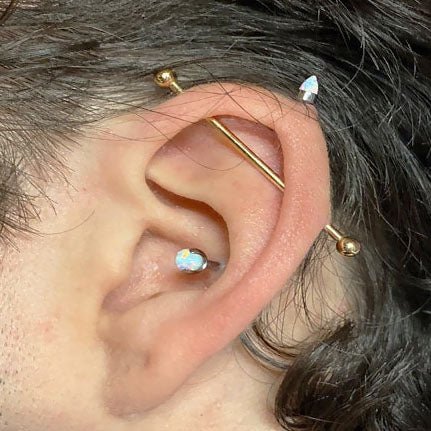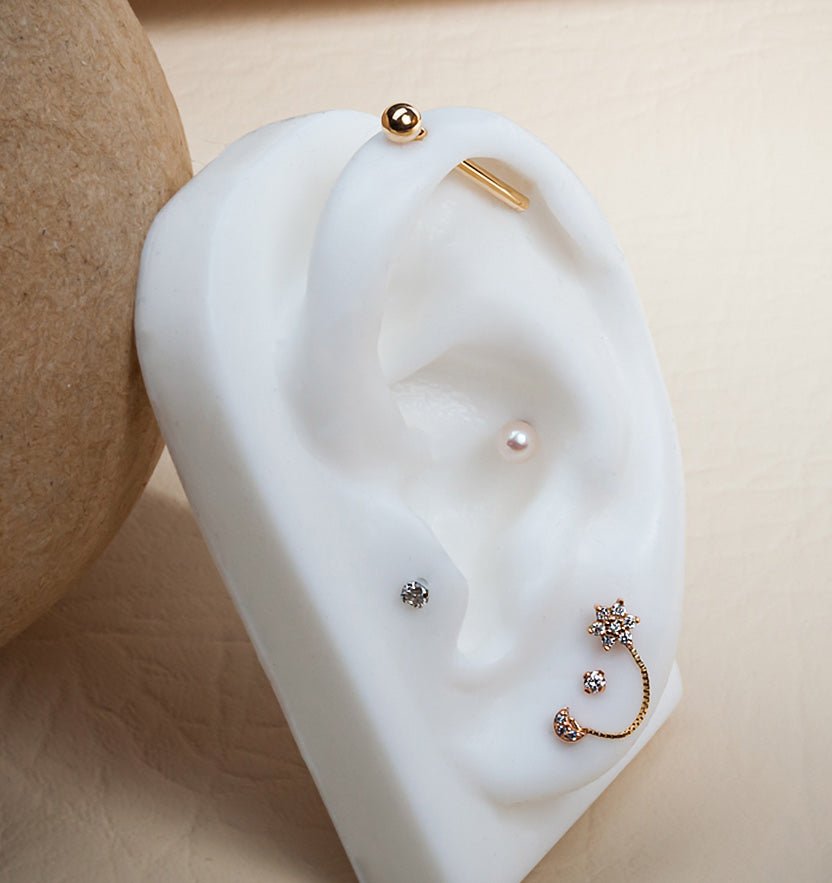The Industrial Piercing: Everything You Need To Know
From piercing care to jewelry styles, discover if your ear is ready for an industrial piercing.


The industrial piercing actually consists of two piercings in one. A straight barbell (sometimes referred to as an industrial barbell when used in this piercing type) connects the two ear piercings, which are usually located in the helix and anti-helix. However, there are variations of the industrial piercing that connect other cartilage piercing types.
The industrial piercing has often been associated with punk styles, however, now that body piercings—cartilage piercings especially—are seeing mainstream popularity, the industrial piercing is becoming less edgy and more of a cute and unique addition to any cartilage party.
Since you will get two piercings at once for your industrial piercing, aftercare practices can be a little more difficult. Additionally, cartilage requires more attention during healing than more fleshy areas, so you need to make sure that you pay attention during healing. The aesthetic of the industrial piercing also depends greatly upon your ear anatomy, so it’s not for everyone.
Here’s everything you need to know about the industrial piercing.
Fun Facts about Industrial Piercings
How Much Does The Industrial Piercing Hurt?
Since the industrial piercing is simply a combination of two cartilage piercing types, the piercing shouldn’t hurt more than any other cartilage piercing. However, since you will undergo two piercings at once, there will be a little more tenderness than if you were to get one piercing at a time. You shouldn’t expect too much pain during the piercing process, but it will be a little more uncomfortable during the first few weeks of healing.
Industrial Piercing Healing Process
The industrial piercing healing process will be the same as any other cartilage piercing. It usually takes around 2 - 3 months to heal, but it could take longer. Talk to your piercer before stopping aftercare practices to make sure that you’re fully healed.
Beyond practicing standard aftercare, with the industrial piercing, you’ll need to be extra careful to avoid snagging your jewelry. The industrial barbell gets easily entangled in hair, which may then pull against the jewelry. In cartilage piercings, it’s very easy to damage the skin, causing complications like hypertrophic scarring. For this reason, some opt for cartilage studs while their industrial piercing heals.
FreshTrends Tips
Aftercare Rules
Beyond standard aftercare practices, here are some tips for aftercare while your industrial piercing heals.
Keep your hair away from the jewelry. As mentioned previously, the industrial barbell easily gets entangled in hair, which can tug at the piercing and cause skin damage. Try to keep your hair up and away from the piercing as it heals. You can also opt for cartilage studs during healing.
Don’t put pressure on the jewelry. This includes over-the-ear headphones and sleeping on your side. Putting pressure on the jewelry can damage the healing piercing and contribute to issues like piercing rejection and jewelry migration. If you must sleep on your side, it’s a good idea to get one industrial piercing at a time so that you can sleep on the non-healing ear.
Choose proper starter jewelry. You need to make sure that your industrial is big enough to allow for swelling, especially since you might see more swelling than usual due to the two piercings. Be careful; the longer barbell will be easier to snag. Choose high quality metal to avoid jewelry rejection or skin sensitivities. You should also choose a plain straight barbell. Any charms or added flair could add weight that pulls at the new piercing, which could cause damage. Additionally, the industrial is usually pierced with a 14G needle, although it can be pierced with a 16G needle. After it’s healed, you can stretch your cartilage, but do so with caution; stretching the cartilage is difficult, takes a long time, and it’s easy to damage your ear. You also want to make sure that your jewelry is internally threaded so that external threads don’t rub against your piercing.


Industrial Jewelry Styles
Perhaps the best thing about the industrial piercing is that it’s really three piercings in one. You can string a straight barbell through the two piercings for the industrial look, or you can fill each piercing with a cartilage stud for the standard cartilage piercing aesthetic.
Industrial barbells are the most common industrial piercing jewelry to be used. They are the same as a straight barbell, although some industrial barbells have a charm in its center, since the industrial piercing allows for this style. Feel free to get creative with your industrial barbell styles.
You can also choose cartilage studs when you’re tired of the industrial look. You can choose studs with a flat disc back or a ball backing.
Related Products
View allWhy Shouldn’t I Get An Industrial Piercing?
The look of an industrial piercing greatly depends on the anatomy of your ear. If you have a smaller ear, you might not be able to accommodate the industrial piercing.
Since you have to heal two piercings at once, if you know that you’re not going to be great with aftercare practices, then you might want to choose something with easier healing. Additionally, it might not make a great first piercing.
Healing cartilage is more susceptible to issues like cartilage bumps or hypertrophic scarring. If you’ve had problems healing cartilage in the past, then it’s a good idea to talk to your piercer before pursuing the industrial piercing.
Industrial Piercing Cost
Although the industrial piercing consists of two piercings, you’ll usually only be charged for one. It typically costs somewhere around $30 - $70. As always, choose a quality piercer over expense. Never go to a piercer who uses a piercing gun. The piercer should use clean needles and gloves, and their piercing studio should look clean and professional.
Industrial Piercing Variations
By far, the most popular industrial ear piercing style connects the helix and anti-helix piercings. However, the industrial technically consists of any two cartilage piercings that are connected with a straight or industrial barbell. While the ideas are endless, here are some popular options.
A vertical industrial piercing can pierce a few different areas of the cartilage. Often, it entails a helix piercing and a conch piercing, two conch piercings, or the rook and the conch.
The double or triple industrial piercing consists of multiple industrial piercings. It’s most common to see them in a standard industrial piercing, but you can get creative with this style.

































